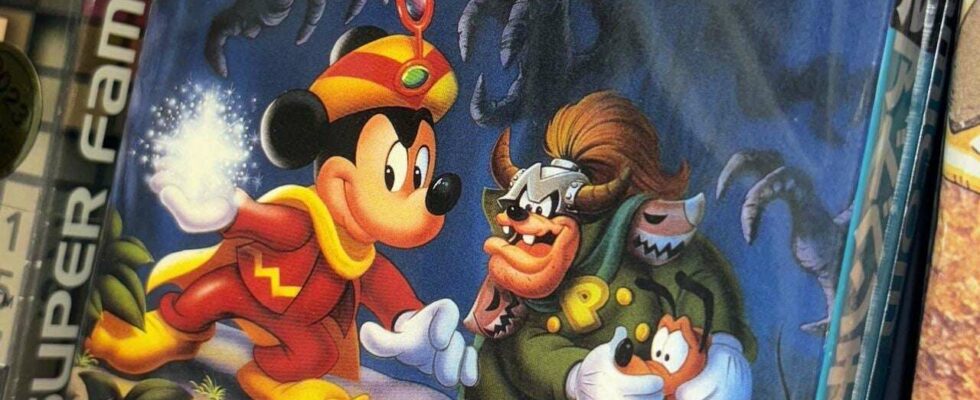L’article évoque la création du jeu « The Magical Quest Starring Mickey Mouse » sur SNES, mettant en lumière le partenariat entre Disney et Capcom. Malgré des difficultés pour retrouver les membres de l’équipe de développement, des interviews avec des figures clés comme Shelley Miles et Noah Dudley ont permis d’explorer l’origine du jeu et la dynamique entre les deux entreprises. Le jeu, salué pour son gameplay et ses graphismes, est aujourd’hui considéré comme un classique, bien qu’inaccessible sur les plateformes modernes.
The Magical Quest Starring Mickey Mouse has consistently been one of our favorite platformers on the SNES, celebrated for its innovative gameplay centered around costume transformations and an exceptional soundtrack by composer Mari Yamaguchi. Over the years, we endeavored to reach out to the development team members to gather insights, delving into old magazines for information. However, we faced several challenging barriers. Most notably, very few individuals involved in the project at Capcom ever publicly shared their experiences collaborating with Disney, and many of those who did have either remained under contract or exited the industry entirely, making contact nearly impossible.
Fortunately, we recently found a way to bypass these hurdles by connecting with a small group of individuals who worked for Disney and Capcom in the early ’90s in the United States. Among them were Shelley Miles, the former Vice President and General Manager of Disney Software, Noah Dudley, a Disney producer assigned to the project, and Joe Morici, the Senior Vice President of Capcom USA.
Miles and Morici were instrumental in signing the initial publishing agreement between Disney and Capcom in the mid-’80s and were still with the company when The Magical Quest Starring Mickey Mouse launched years later. Dudley kept close ties with the development team in Japan and was tasked with representing Disney on the project. They provided fascinating insights into the game’s creation, as detailed below. However, it may be helpful to first take a brief look back at Disney’s foray into gaming and the establishment of their video game division: Disney Computer Software Ltd., which later became Disney Software.
The Birth of Disney Software
Prior to the founding of Disney Computer Software in 1988, the company had licensed several of its beloved characters and films for video games for nearly ten years. Disney collaborated with companies like Atari, Nintendo, Sierra On-Line, Midway Games, Epoch, Hudson Soft, and Gremlin Interactive. However, they had yet to create an internal entity within the company to manage its game production at its Burbank headquarters, with earlier games being handled by the educational division or developed externally with little oversight.
This began to change between 1987 and 1988 when the consumer products division hired its first in-house producers, David Mullich and Cathy Gamboz, to take a more active role in game development.
Shelley Miles recalls, « Disney had an educational division, and software really fell under that category. As the company evolved, the consumer products division started focusing more on games and decided in 1988 to create a video game based on an upcoming film featuring Bob Hoskins and Christopher Lloyd. However, they struggled to find a publisher willing to take on the license, leaving them with no way to distribute the game. »
« They had a major film coming out, » Miles continues. « The consumer products team was eager to have a game to accompany it. They attempted to secure a licensing agreement, which was typical of Disney, but given the confidentiality of the script and their tight timeline, they couldn’t find anyone willing. They then approached us at Disney Records, saying, ‘Hey, you’re vertically integrated. You have distribution. Can you help us distribute the game?’ Initially, the idea was that Disney Music would only handle distribution, but soon it became clear that no one was managing the game’s development or aspects like packaging and manual design. Within nine months, the Silent Software team and Disney Records completed five versions of the game for various platforms (MS-DOS, Commodore Amiga, Atari ST, Apple II, and Commodore 64), and Miles humorously noted that the experience « almost killed us. » Despite the challenges, the game sold over 100,000 copies, marking a modest success for the company. On September 15, 1988, Disney filed to incorporate Disney Computer Software, later shortened to Disney Software. Steve McBeth, a Disney executive, focused on business strategy and licensing, while Miles took on the critical role of recruiting more producers for video game production. Among those hired during this time were Roger Hector (who would later become a project manager at Sega) and Noah Dudley (future Disney Imagineer who developed several virtual reality attractions).
« I remember conducting extensive research, discovering Roger, and deciding we needed to build this, » Miles shared. « We then started discussing how to structure it all. Who are the right people? We wanted to prioritize high production values since children were growing up with TV and video experiences. However, we also recognized that gameplay was paramount, and fun was essential. We hired several individuals with TV experience, placing them under the game’s management. The game took precedence, preventing us from putting our intellectual properties into subpar games. »
Dudley recalls, « When Who Framed Roger Rabbit performed well, the thought was to replicate that success. This led others to
